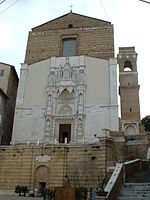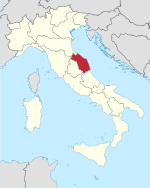Biblioteca comunale Luciano Benincasa
AnconaCulture in le MarcheLibraries established in 1669Libraries in Ancona

The Biblioteca comunale Luciano Benincasa (the "Luciano Benincasa Municipal Library") is located in Ancona, Italy, in the Palazzo Mengoni-Ferretti, at the central Piazza del Plebiscito (Plebiscite Square).
Excerpt from the Wikipedia article Biblioteca comunale Luciano Benincasa (License: CC BY-SA 3.0, Authors, Images).Biblioteca comunale Luciano Benincasa
Via Giacomo Matteotti, Ancona
Geographical coordinates (GPS) Address Nearby Places Show on map
Geographical coordinates (GPS)
| Latitude | Longitude |
|---|---|
| N 43.619736111111 ° | E 13.512616666667 ° |
Address
Porta San Pietro
Via Giacomo Matteotti
60121 Ancona
Marche, Italy
Open on Google Maps









